

The Mexican Gray Wolf Recovery Program Home. International Wolf Center Learn - The Arctic Wolf. Wolf Facts Sheet - Canadian Geographic Kids! Kids / animal-facts The wolf is the largest wild member of the dog family.

It can be many colours, from white to black, but most often grey. The wolf has short, soft under-fur covered by coarse, outer guard hairs. The under-fur is dense and insulates the wolf against the cold. Stiff hairs also protect its footpads. Its size is similar to that of a German shepherd, but it is leaner with bigger feet and longer legs. Packs normally occupy a set home range and frequent the same paths. Critter Catalog, Canis lupus, gray wolf. What do they look like?
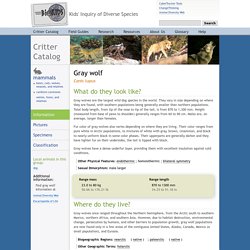
Gray wolves are the largest wild dog species in the world. They vary in size depending on where they are found, with southern populations being generally smaller than northern populations. Total body length, from tip of the nose to tip of the tail, is from 870 to 1,300 mm. Height (measured from base of paws to shoulder) generally ranges from 60 to 90 cm. Males are, on average, larger than females. Fur color of gray wolves also varies depending on where they are living. Gray wolves have a dense underfur layer, providing them with excellent insulation against cold conditions. male larger Range mass 23.0 to 80 kg 50.66 to 176.21 lb Range length 870 to 1300 mm 34.25 to 51.18 in Where do they live?
Kids' Planet ESPECIES Animal Fact Sheets. Wolves, Wolf Pictures, Wolf Facts. Wolves are legendary because of their spine-tingling howl, which they use to communicate.

A lone wolf howls to attract the attention of his pack, while communal howls may send territorial messages from one pack to another. Some howls are confrontational. Much like barking domestic dogs, wolves may simply begin howling because a nearby wolf has already begun. Gray Wolf Facts and Pictures. USFWS: Gray Wolf in the Western Great Lakes. Chronology of Federal Actions Affecting Gray Wolf ESA Status in the Western Great Lakes States Dec. 28, 2011: Final Rule to delist the Western Great Lakes DPS - Revising the Listing of the Gray Wolf (Canis lupus) in the Western Great Lakes Aug. 26, 2011: Comment Period Reopens on Proposal to delist Western Great Lakes DPS.
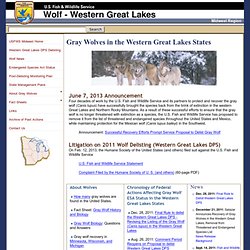
WI - Official Website - Grey Wolf. Animal Summary Keeley, the attention loving female, and Nuka, the standoffish male, were born in the spring of 2005.

They have made their home at the zoo since 2006 on loan from the Wildlife Science Center in Lake Forest, Minnesota. Facts A wolf that is driven from the pack or that has left on its own called a lone wolf. It avoids contact with packs and rarely howls. Western Gray Wolf: U.S. Fish and Wildlife Service. Wolf restoration in the Northern Rocky Mountains (NRM) has been an amazing success thanks to both the resiliency of wolves and the cooperative efforts of Federal, State, and Tribal agencies, conservation groups, and private citizens; including ranchers, sportsmen, and outfitters.
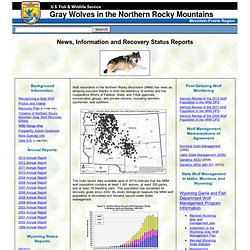
The most recent data available (end of 2013) indicate that the NRM wolf population contains at least 1,691 wolves, at least 320 packs, and at least 78 breeding pairs. This population has exceeded its recovery goals since 2002. By every biological measure the NRM wolf population is recovered and remains secure under State management. Long-term, the Service expects the entire NRM population to maintain a long-term average of around 1,000 wolves. These wolves represent a 400-mile southern range extension of a vast contiguous wolf population that numbers over 12,000 wolves in western Canada and about 65,000 wolves across all of Canada and Alaska. Recent Actions: Federal Register Notice Federal Register Notice. Gray wolf. The gray wolf or grey wolf (Canis lupus) is a canid native to the wilderness and remote areas of North America, Eurasia, and North Africa.
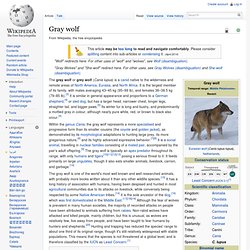
It is the largest member of its family, with males averaging 43–45 kg (95–99 lb), and females 36–38.5 kg (79–85 lb).[3] It is similar in general appearance and proportions to a German shepherd,[4] or sled dog, but has a larger head, narrower chest, longer legs, straighter tail, and bigger paws.[5] Its winter fur is long and bushy, and predominantly a mottled gray in colour, although nearly pure white, red, or brown to black also occur.[4] Etymology The English word "wolf" stems from the Old English wulf, which is itself thought to be derived from the Proto-Germanic *wulfaz, from the Proto-Indo-European root *wlqwos/*lukwos.[21] Old English literature contains several instances of Anglo-Saxon kings and warriors taking on wulf as a prefix or suffix in their names.
All you need to know about Wolves. Yellowstone National Park - Potential Interactions Between Bears & Wolves. With the reintroduction of gray wolves (Canis lupus) to Yellowstone National Park (YNP), much interest has been shown regarding the effects of a restored wolf population on both grizzly bears (Ursus arctos horribilis) and black bears (Ursus americanus).
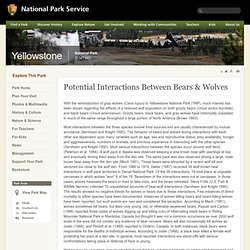
Grizzly bears, black bears, and gray wolves have historically coexisted in much of the same range throughout a large portion of North America (Brown 1993). Most interactions between the three species involve food sources and are usually characterized by mutual avoidance (Servheen and Knight 1990). The behavior of bears and wolves during interactions with each other are dependent upon many variables such as age, sex and reproductive status, prey availability, hunger and aggressiveness, numbers of animals, and previous experience in interacting with the other species (Servheen and Knight 1990). Most serious interactions between the species occur around wolf dens (Peterson et al. 1984). Literature Cited Brown, G. 1993. Haber, G.C. 1987. Basic Facts About Gray Wolves. Gray wolves range in color from grizzled gray or black to all-white.
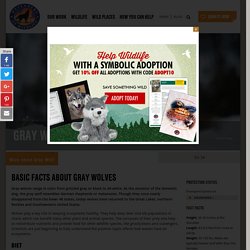
As the ancestor of the domestic dog, the gray wolf resembles German shepherds or malamutes. Though they once nearly disappeared from the lower 48 states, today wolves have returned to the Great Lakes, northern Rockies and Southwestern United States. Wolves play a key role in keeping ecosystems healthy. They help keep deer and elk populations in check, which can benefit many other plant and animal species. The carcasses of their prey also help to redistribute nutrients and provide food for other wildlife species, like grizzly bears and scavengers. Wolves of the World. Once abundant throughout North America, wolves have over the past 200 years felt a constant impact of the Human Population.
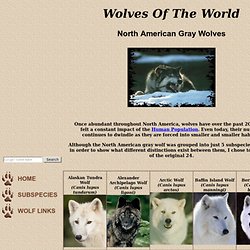
Even today, their number continues to dwindle as they are forced into smaller and smaller habitat. Although the North American gray wolf was grouped into just 5 subspecies in 1995, in order to show what different distinctions exist between them, I chose to show all of the original 24. Red Wolves The red wolf is listed separately because for so long it was viewed as it's own separate species (the Canis rufus). Title: Arctic wolves and their prey - Mech. Arctic Wolves and Their Prey L. David Mech Biological Resources Division U.S. Geological Survey. Wolf Classification.